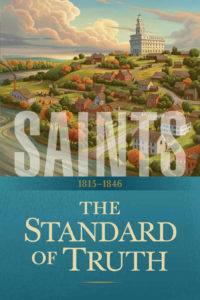Note: A report from Bryan Buchanan, Benchmark Books specialist and AML reviewer, on the recent release of the first volume of the four-volume series Saints. It’s an official publication from the Church. It’s worthwhile to note here that this volume is available at various outlets like Deseret Book and Church Distribution for under $6.00. Given that it is 700 pages, this is a great price. Even better, the book can be downloaded free for Deseret Bookshelf. I’ve also found it on amazon.com, a free download of the e-book version, which I’m reading now. Thanks, Bryan for this report. JN
AML was invited to attend the release event for the first volume of Saints last week. Here are some of the highlights from the presentation.
Elder Dale Renlund, an advisor to the Church History Department, was the first to speak. He emphasized that “history is precious” to both church members and God. From the early days of Mormonism, the need to document history was commanded—a revelation dictated the day the church was organized enjoined, “Behold there Shall a Record be kept among you.” The following years included both “exciting rushes of revelation” but also the moments of ordinary lives. Renlund shared how reading Saints “transported and inspired” him. He discussed various individuals mentioned in this volume and noted, “If you don’t know who these people are, Saints is for you.” He closed his remarks by summarizing Saints as “accessible, accurate and compelling.”
Next, Elder Steven Snow, church historian and recorder, stated—with more than a touch of relief—that he had “looked forward to this for six years.” It was truly a “labor of love for many.” To give context for Saints, he described how the church had previously published two multi-volume attempts at telling their story: History of the Church and Comprehensive History of the Church. In the nearly ninety years since the latter was issued, many changes have taken place, Snow noted. “Scholarship and knowledge have increased” since then. With a smile, he related Brigham Young’s instructions to the church historians in 1861 (recorded in Wilford Woodruff’s journal): “write in a Narrative style” but “write ownly about one tenth part as much as we have done.” He described the meticulous process of creating Saints, declaring that “every line of dialogue” was supported by historical facts. For non-English speakers, their primary vehicle thus far for Mormon history has been short treatments like Our Heritage. As of today, Saints is available in fourteen languages with hard copy editions coming by the end of the year (often subsidized by the church). He hopes that this combination of “familiar stories alongside lesser-known” accounts will benefit church members worldwide.
He was followed by Matt Grow, director of publications for the Church History Department. Grow noted that it was fitting that this event took place in the Church History Library since Saints was based on records “painstakingly” kept over the years. He emphasized that Saints was designed to be narrative history, combining historians and professional writers to create an accessible text. The book is structured around lives of “real” Latter-day Saints, “3-D characters,” both “leaders and laity, women and men.” Another key feature of this history is the “global nature” of the story evident from the first page. The overriding structural element of the series will be temple building—volume one ends with ordinances being performed in the Nauvoo Temple, for example. Grow also emphasized the multi-layered nature of the series—the text is heavily footnoted with the notes including primary sources and also references to topic essays at lds.org (in the online version, these are hyperlinked). To coincide with the release of Saints, they have published more than a hundred new topic essays.
The final speaker was Elder Quentin Cook, also an advisor to the Church History Department. On behalf of the Quorum of the Twelve and the First Presidency, he expressed thanks to those who made this “meticulously” researched history available. He explained that the subtitles for the four volumes come from Joseph Smith’s 1842 letter to newspaper editor John Wentworth: Volume 1—“Standard of Truth” (ending with the Nauvoo Temple), Volume 2—“No Unhallowed Hand” (ending with the dedication of the Salt Lake Temple), Volume 3—“Boldly, Nobly and Independent” (ending with the dedication of the Swiss Temple), and Volume 4—“Sounded in Every Ear” (ending with temples in South America, Africa and Asia). Cook noted that the remaining three volumes will be published over the course of the next four years. He concluded by stating that Saints is an “official history,” approved by the First Presidency and reviewed by many: auxiliary leaders, church leaders and historians.

